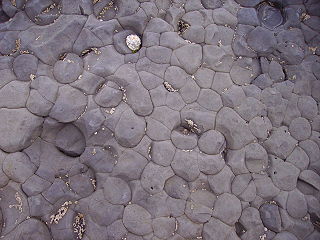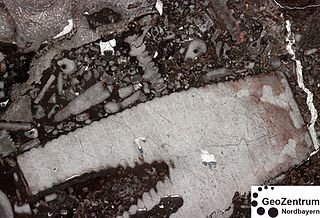Related Research Articles

Limestone is a type of carbonate sedimentary rock which is the main source of the material lime. It is composed mostly of the minerals calcite and aragonite, which are different crystal forms of CaCO3. Limestone forms when these minerals precipitate out of water containing dissolved calcium. This can take place through both biological and nonbiological processes, though biological processes, such as the accumulation of corals and shells in the sea, have likely been more important for the last 540 million years. Limestone often contains fossils which provide scientists with information on ancient environments and on the evolution of life.

Siltstone, also known as aleurolite, is a clastic sedimentary rock that is composed mostly of silt. It is a form of mudrock with a low clay mineral content, which can be distinguished from shale by its lack of fissility.

Mudstone, a type of mudrock, is a fine-grained sedimentary rock whose original constituents were clays or muds. Mudstone is distinguished from shale by its lack of fissility.

A nummulite is a large lenticular fossil, characterised by its numerous coils, subdivided by septa into chambers. They are the shells of the fossil and present-day marine protozoan Nummulites, a type of foraminiferan. Nummulites commonly vary in diameter from 1.3 cm to 5 cm and are common in Eocene to Miocene marine rocks, particularly around southwest Asia and the Mediterranean in the area that once constituted the Tethys Ocean, such as Eocene limestones from Egypt or from Pakistan. Fossils up to six inches wide are found in the Middle Eocene rocks of Turkey. They are valuable as index fossils.
The Folk classification, in geology, is a technical descriptive classification of sedimentary rocks devised by Robert L. Folk, an influential sedimentary petrologist and Professor Emeritus at the University of Texas.

The Dunham classification system for carbonate sedimentary rocks was originally devised by Robert J. Dunham in 1962, and subsequently modified by Embry and Klovan in 1971 to include coarse-grained limestones and sediments that had been organically bound at the time of deposition. The modified Dunham Classification has subsequently become the most widely employed system for the classification of carbonate sedimentary rocks with 89% of workers currently adopting this system over the alternative Folk classification scheme

A carbonate platform is a sedimentary body which possesses topographic relief, and is composed of autochthonic calcareous deposits. Platform growth is mediated by sessile organisms whose skeletons build up the reef or by organisms which induce carbonate precipitation through their metabolism. Therefore, carbonate platforms can not grow up everywhere: they are not present in places where limiting factors to the life of reef-building organisms exist. Such limiting factors are, among others: light, water temperature, transparency and pH-Value. For example, carbonate sedimentation along the Atlantic South American coasts takes place everywhere but at the mouth of the Amazon River, because of the intense turbidity of the water there. Spectacular examples of present-day carbonate platforms are the Bahama Banks under which the platform is roughly 8 km thick, the Yucatan Peninsula which is up to 2 km thick, the Florida platform, the platform on which the Great Barrier Reef is growing, and the Maldive atolls. All these carbonate platforms and their associated reefs are confined to tropical latitudes. Today's reefs are built mainly by scleractinian corals, but in the distant past other organisms, like archaeocyatha or extinct cnidaria were important reef builders.

In geology, a bed is a layer of sediment, sedimentary rock, or volcanic rock "bounded above and below by more or less well-defined bedding surfaces". Specifically in sedimentology, a bed can be defined in one of two major ways. First, Campbell and Reineck and Singh use the term bed to refer to a thickness-independent layer comprising a coherent layer of sedimentary rock, sediment, or pyroclastic material bounded above and below by surfaces known as bedding planes. By this definition of bed, laminae are small beds that constitute the smallest (visible) layers of a hierarchical succession and often, but not always, internally comprise a bed.

A sabkha is a coastal, supratidal mudflat or sandflat in which evaporite-saline minerals accumulate as the result of semiarid to arid climate. Sabkhas are gradational between land and intertidal zone within restricted coastal plains just above normal high-tide level. Within a sabkha, evaporite-saline minerals sediments typically accumulate below the surface of mudflats or sandflats. Evaporite-saline minerals, tidal-flood, and aeolian deposits characterize many sabkhas found along modern coastlines. The accepted type locality for a sabkha is at the southern coast of the Persian Gulf, in the United Arab Emirates. Evidence of clastic sabkhas are found in the geological record of many areas, including the UK and Ireland. Sabkha is a phonetic transliteration of the Arabic word used to describe any form of salt flat. A sabkha is also known as a sabkhah,sebkha, or coastal sabkha.

Under the Dunham classification system of limestones, a wackestone is defined as a mud-supported carbonate rock that contains greater than 10% grains. Most recently, this definition has been clarified as a carbonate-dominated rock in which the carbonate mud component supports a fabric comprising 10% or more very fine-sand grade or larger grains but where less than 10% of the rock is formed of grains larger than sand grade .

Under the Dunham classification system of limestones, a grainstone is defined as a grain-supported carbonate rock that contains less than 1% mud-grade material. This definition has recently been clarified as a carbonate-dominated rock that does not contain any carbonate mud and where less than 10% of the components are larger than 2 mm. The spaces between grains may be empty (pores) or filled by cement.

Under the Dunham classification system of limestones, a packstone is defined as a grain-supported carbonate rock that contains 1% or more mud-grade fraction. This definition has been clarified by Lokier and Al Junaibi (2016) as a carbonate-dominated lithology containing carbonate mud in a fabric supported by a sand grade grain-size fraction and where less than 10% of the volume consists of grains >2 mm.

Floatstone is a type of carbonate rock.
Calcilutite is a type of limestone that is composed of predominantly, more than 50 percent, of either clay-size or both silt-size and clay-size detrital (transported) carbonate grains. These grains consist either of fossil fragments, ooids, intraclasts, pellets, other grains, or some combination of them. The term calcilutite was originally proposed in 1903 by Grabau as a part of his calcilutite, calcarenite and calcirudite classification system based upon the size of the detrital grains composing a limestone. In the original classification of limestone according to the dominant grain-size, calcisiltites were not named and are classified as calcilutite. In this classification, which the majority of geologists follow, a calcilutite consists of both silt- and clay-size, less than 0.062 mm in diameter, grains. It is the carbonate equivalent of a mudstone. Calcilutites can accumulate in a wide variety of marine and lacustrine environments.

Rudstone is a type of carbonate rock.

Bafflestone is a type of carbonate rock.
Bindstone is a special type of carbonate rock in the Dunham classification. The term did not appear in the original Dunham classification from 1962 and was introduced by Embry and Klovan 1971 in the modified Dunham classification.
A framestone is a special type of carbonate rock in the Dunham classification.

Molar tooth structures are ribbon-like veins and nodules of calcite that are found widespread in Precambrian carbonate sedimentary rocks between approximately 2600 to 570 million years ago. Their mechanism for formation remains debated, with hypothesis including the generation of methane gas within sediments, pumping of water through sediment by wave action, tsunamis, and bacterial processes.

Teepee structures are sedimentary structures interpreted to represent formation in peritidal environments. Teepees are largely the result of evaporation of water and subsequent precipitation of minerals within sediment, resulting in expansion and buckling to form a teepee-like shape. Their name originates from geologists working in the Guadalupe Mountains, who noted their appearance in cross-section resembles that of a Native American teepee.
References
- ↑ Dunham, Robert J. (1962). Ham, W.E. (ed.). "Classification of Carbonate Rocks according to Depositional Texture". Classification of Carbonate Rocks, A Symposium: 108–121.
- ↑ Dunham, Robert J. (1962). Ham, W.E. (ed.). "Classification of Carbonate Rocks according to Depositional Texture". Classification of Carbonate Rocks, A Symposium: 121.
- ↑ Embry, Ashton F.; Klovan, J. Edward (1971-12-01). "A late Devonian reef tract on northeastern Banks Island, N.W.T". Bulletin of Canadian Petroleum Geology. 19 (4): 730–781. ISSN 0007-4802.
- ↑ Embry, Ashton F.; Klovan, J. Edward (1971-12-01). "A late Devonian reef tract on northeastern Banks Island, N.W.T". Bulletin of Canadian Petroleum Geology. 19 (4): 737. ISSN 0007-4802.
- ↑ Lokier, Stephen W.; Al Junaibi, Mariam (2016). "The petrographic description of carbonate facies: are we all speaking the same language?". Sedimentology. 63 (7): 1843–1885. doi: 10.1111/sed.12293 . ISSN 1365-3091.
- ↑ Lokier, Stephen W.; Al Junaibi, Mariam (2016). "The petrographic description of carbonate facies: are we all speaking the same language?". Sedimentology. 63 (7): 1879. doi: 10.1111/sed.12293 . ISSN 1365-3091.